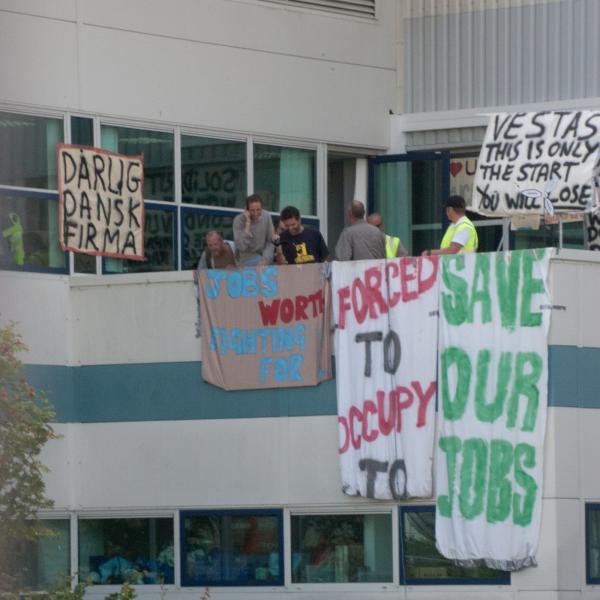The UK’s Red and Green Revolt

After 18 days of barricading themselves inside Vestas Windsystems on the Isle of Wight, six wind turbine workers protesting the factory’s closure were finally forced to end their occupation. Hundreds of supporters stood outside the factory gates on August 7, watching as the court-ordered bailiffs arrived with a warrant to repossess the property. Refusing to make it easy for the bailiffs, the workers retreated to a second-floor balcony, where they addressed the crowd via an amplified cell phone call.
‘‘Thank you for showing up and supporting us every day,” said one of the workers, pacing back and forth as he awaited the bailiffs, who were making their way through the building. “We came here to save our jobs, and it’s turned into something much bigger than that.”
By the time the bailiffs arrived, amid boos from the crowd, several of the workers had already rapelled from the balcony. Another sat on the ledge with a homemade sign reading, “This is only the start” draped next to him. The bailiffs tried to coax him back, but he was insistent on leaving under his own terms. So he jumped, landing on a pile of bushes almost two stories down. When he emerged moments later, with his arms raised victoriously, the crowd cheered and began chanting, “The fight goes on!”
This sentiment has remained the case nearly six months after it all began, thanks to what the Guardian called “a unique ‘red and green’ army of trade union and environmental campaigners.” The solidarity that has formed between these groups marks a historic change from a relationship dominated mainly by the view that the two sides’ agendas were mutually exclusive.
When the Dutch-owned Vestas announced in late April that it would be cutting 600 jobs by closing the only wind turbine factory in the UK, both groups saw an opportunity for collaboration. Because Vestas wasn’t a union shop, efforts had to first be made through labor.
In the months prior to the announcement, some employees joined the left-led National Union of Rail, Maritime, and Transport Workers. From this position, many were able to begin organizing a resistance strategy. But the prevailing sentiment among the nonunionized was still one of hopelessness.
In an effort to change that, a group of socialist environmental activists from Workers’ Climate Action started camping out near the plant. During the day they passed out leaflets by the gates. The workers were slow to warm up, but soon they were convinced that taking action could make a difference. Within a week of forming an occupation committee, 25 workers had begun the sit-in.

Media Savvy
Thanks to several good strategies on their part, the most important being complete openness and interaction with the media, the Vestas workers became something of a national sensation. The BBC ran a story about life “on the inside,” which put a human face on the occupation and showed how the all-male group coped with hunger—by raiding the vending machine—and boredom—by inventing games with office supplies.
Vestas, on the other hand, much to its own detriment, remained remarkably silent. As the Financial Times of London noted, “Rather than coming out with a robust defense and a good finger-pointing at, say, market forces or government policy, the company is only issuing the barest of peeps to the media.”
One explanation, as the Financial Times pointed out, is that renewable energy companies don’t have the experience fossil fuel companies have when it comes to being seen as the bad guys. Secondly, Vestas didn’t have much of an argument. Not only had the company just recorded a 59 percent sales increase, but it was rumored that it had turned down a government subsidy of more than $10 million.
Energy and Climate Secretary Ed Miliband also found himself a target of the Save Vestas Campaign, having promised the creation of thousands of green jobs only a week before the occupation. With help from the British group Campaign against Climate Change, the workers were able to set up a website and organize demonstrations in London. At one point, seven activists wearing the red and green campaign colors glued themselves in a chain across the entrance of the Department for Energy and Climate Change and demanded that the factory be kept open.
The throng of supporters outside the factory gates continued to swell as more people from England began arriving. Several hundred climate activists from leading groups like Camp for Climate Action and Plane Stupid showed up after the annual Big Green Gathering in Somerset was canceled. But the greatest act of solidarity came when seven climate activists opened a second front by occupying the roof of another building owned by Vestas on the Isle of Wight. Remaining for 11 days, several of which were after the workers had been evicted, they declared their intentions with a big, colorful banner for all entering the island by ferry to see: “Vestas Workers—Solidarity in Occupation. Save Green Jobs.”
Blockades
After both occupations ended, the focus shifted toward blocking the blades that were still inside the factory—the final piece preventing Vestas from shutting it down completely. This was seen as the best leverage for winning the workers’ demands, which now included the reinstatement of 11 workers who had been fired for participating in the occupation.
They succeeded for several days at first by erecting a scafold-pole tripod that blocked the gate and prevented the blades from being moved onto a barge. The protesters took turns occupying the tripod day and night, while Vestas countered by shining a massive bright light back at them.
In one particularly daring move, protesters drove power boats from the Isle of Wight to Southampton on the mainland of England, where they used a boat show as cover to sneak into the city’s docks and occupy cranes and other vessels that were loading already transported turbines for delivery to the United States. Others chained themselves to the barge intended to fetch the remaining blades from the factory.
Meanwhile, the blockade outside the factory gates held for nearly another week, until Vestas obtained the court order it needed to have the protesters removed. Over 100 police officers were called in from the mainland to break up the camp and clear the gate area so the blades could be taken away. Vestas then expanded its perimeter fence, pushing the protesters away from the gates and making it more difficult to hang banners.
Ongoing Efforts
Although this effectively put an end to the direct action campaign, the fight continues in other ways. Messages of support from around the world—including songs about the occupation—continue to be posted on savevestas.wordpress.com. And rallies are still being organized.
Some of the workers attended and spoke at the recent Wave climate rally in London, which saw thousands of people march on Parliament to demand concrete action on climate change. A week later, in Copenhagen, one of the Vestas workers took part in a workshop organized by the Red-Green Alliance for Klimaforum, an alternative conference being held alongside the official U.N. summit.
With hundreds of workers still unemployed and the UK failing miserably in its efforts to meet emission reduction targets, there is a case to be made for the importance of green jobs. The Save Vestas Campaign is now calling not only for the reinstatement and compensation of fired workers, but also for the reopening and nationalization of the factory, which it believes can stay in business with a commitment by the British government to build renewable energy plants.
Even if these goals aren’t realized by the Save Vestas Campaign, the workers and their supporters have brought together two formerly disparate movements. This in itself is a success because more green labor struggles are on the horizon, given the likely creation of more renewable energy goals by governments around the world. Having a model framework such as Save Vestas from which to draw ideas will no doubt be valuable. With good reason, then, “The fight goes on!”
